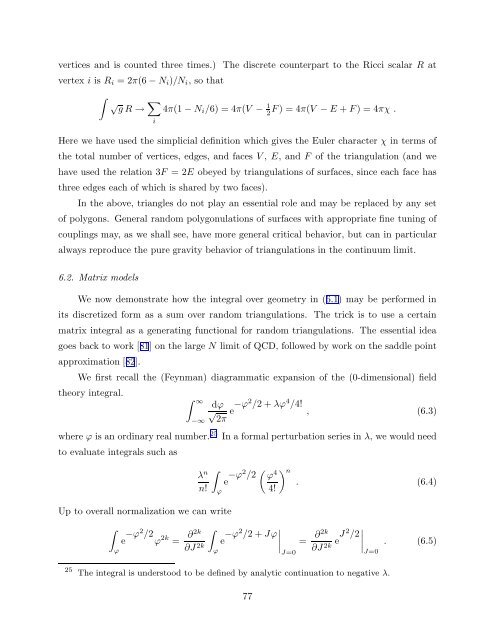arXiv:hep-th/9304011 v1 Apr 5 1993
arXiv:hep-th/9304011 v1 Apr 5 1993
arXiv:hep-th/9304011 v1 Apr 5 1993
You also want an ePaper? Increase the reach of your titles
YUMPU automatically turns print PDFs into web optimized ePapers that Google loves.
vertices and is counted <strong>th</strong>ree times.) The discrete counterpart to <strong>th</strong>e Ricci scalar R at<br />
vertex i is R i = 2π(6 − N i )/N i , so <strong>th</strong>at<br />
∫ √g R →<br />
∑<br />
i<br />
4π(1 − N i /6) = 4π(V − 1 F ) = 4π(V − E + F ) = 4πχ .<br />
2<br />
Here we have used <strong>th</strong>e simplicial definition which gives <strong>th</strong>e Euler character χ in terms of<br />
<strong>th</strong>e total number of vertices, edges, and faces V , E, and F of <strong>th</strong>e triangulation (and we<br />
have used <strong>th</strong>e relation 3F = 2E obeyed by triangulations of surfaces, since each face has<br />
<strong>th</strong>ree edges each of which is shared by two faces).<br />
In <strong>th</strong>e above, triangles do not play an essential role and may be replaced by any set<br />
of polygons. General random polygonulations of surfaces wi<strong>th</strong> appropriate fine tuning of<br />
couplings may, as we shall see, have more general critical behavior, but can in particular<br />
always reproduce <strong>th</strong>e pure gravity behavior of triangulations in <strong>th</strong>e continuum limit.<br />
6.2. Matrix models<br />
We now demonstrate how <strong>th</strong>e integral over geometry in (6.1) may be performed in<br />
its discretized form as a sum over random triangulations. The trick is to use a certain<br />
matrix integral as a generating functional for random triangulations. The essential idea<br />
goes back to work [81] on <strong>th</strong>e large N limit of QCD, followed by work on <strong>th</strong>e saddle point<br />
approximation [82].<br />
We first recall <strong>th</strong>e (Feynman) diagrammatic expansion of <strong>th</strong>e (0-dimensional) field<br />
<strong>th</strong>eory integral.<br />
∫ ∞<br />
−∞<br />
dϕ<br />
√<br />
2π<br />
e −ϕ2 /2 + λϕ 4 /4! , (6.3)<br />
where ϕ is an ordinary real number. 25 In a formal perturbation series in λ, we would need<br />
to evaluate integrals such as<br />
λ n<br />
n!<br />
Up to overall normalization we can write<br />
∫<br />
ϕ<br />
e −ϕ2 /2 ϕ 2k =<br />
∂2k<br />
∫<br />
∂J 2k ∫ϕ<br />
ϕ<br />
e −ϕ2 /2 ( ϕ 4 ) n<br />
. (6.4)<br />
4!<br />
e −ϕ2 /2 + Jϕ ∣ ∣ ∣∣<br />
J=0<br />
= ∂2k<br />
∂J 2k eJ 2 /2 ∣ ∣<br />
∣∣J=0 . (6.5)<br />
25 The integral is understood to be defined by analytic continuation to negative λ.<br />
77
















